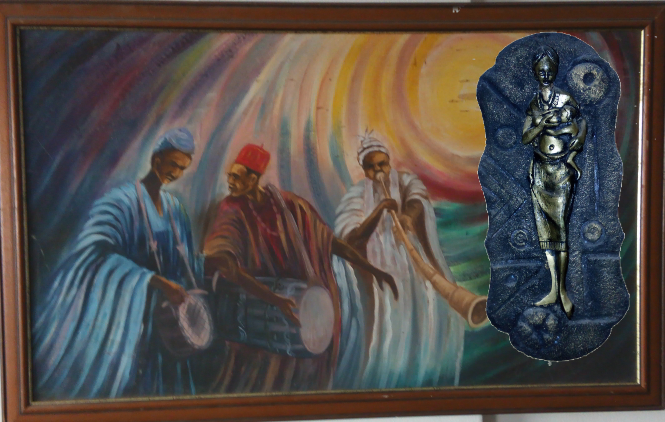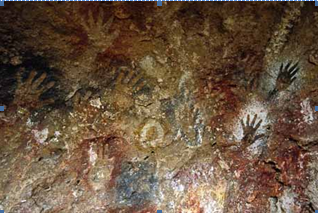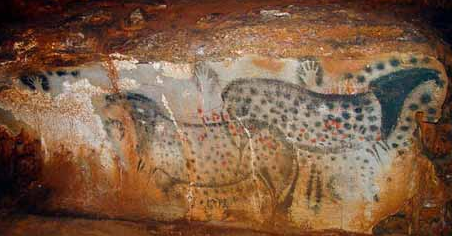RESEARCH ON ART
Art is a diverse range of human activities in creating visual, auditory or performing artifacts (artworks), expressing the author's imaginative or technical skill, intended to be appreciated for their beauty or emotional power. In their most general form these activities include the production of works of art, the criticism of art, the study of the history of art, and the aesthetic dissemination of art.
The oldest documented forms of art are visual arts, which include creation of images or objects in fields including today painting, sculpture, printmaking, photography, and other visual media.
HISTORY OF ART
Sculptures, cave paintings, rock paintings and petroglyphs from the Upper Paleolithic dating to roughly 40,000 years ago have been found, but the precise meaning of such art is often disputed because so little is known about the cultures that produced them. The oldest art objects in the world—a series of tiny, drilled snail shells about 75,000 years old—were discovered in a South African cave. Containers that may have been used to hold paints have been found dating as far back as 100,000 years. Etched shells by Homo erectus from 430,000 and 540,000 years ago were discovered in 2014.
Many great traditions in art have a foundation in the art of one of the great ancient civilizations: Ancient Egypt, Mesopotamia, Persia, India, China, Ancient Greece, Rome, as well as Inca, Maya, and Olmec. Each of these centers of early civilization developed a unique and characteristic style in its art. Because of the size and duration of these civilizations, more of their art works have survived and more of their influence has been transmitted to other cultures and later times. Some also have provided the first records of how artists worked. For example, this period of Greek art saw a veneration of the human physical form and the development of equivalent skills to show musculature, poise, beauty, and anatomically correct proportions.
In Byzantine and Medieval art of the Western Middle Ages, much art focused on the expression of subjects about Biblical and religious culture, and used styles that showed the higher glory of a heavenly world, such as the use of gold in the background of paintings, or glass in mosaics or windows, which also presented figures in idealized, patterned (flat) forms. Nevertheless, a classical realist tradition persisted in small Byzantine works, and realism steadily grew in the art of Catholic Europe.
The history of twentieth-century art is a narrative of endless possibilities and the search for new standards, each being torn down in succession by the next. Thus the parameters of impressionism, Expressionism, Fauvism, Cubism, Dadaism, Surrealism, etc. cannot be maintained very much beyond the time of their invention. Increasing global interaction during this time saw an equivalent influence of other cultures into Western art. Thus, Japanese woodblock prints (themselves influenced by Western Renaissance draftsmanship) had an immense influence on impressionism and subsequent development. Later, African sculptures were taken up by Picasso and to some extent by Matisse. Similarly, in the 19th and 20th centuries the West has had huge impacts on Eastern art with originally western ideas like Communism and Post-Modernism exerting a powerful influence.
Modernism, the idealistic search for truth, gave way in the latter half of the 20th century to a realization of its unattainability. Theodor W. Adorno said in 1970, "It is now taken for granted that nothing which concerns art can be taken for granted any more: neither art itself, nor art in relationship to the whole, nor even the right of art to exist." Relativism was accepted as an unavoidable truth, which led to the period of contemporary art and postmodern criticism, where cultures of the world and of history are seen as changing forms, which can be appreciated and drawn from only with skepticism and irony. Furthermore, the separation of cultures is increasingly blurred and some argue it is now more appropriate to think in terms of a global culture, rather than of regional ones.
TYPES OF ART: forms, genre, media and style
The creative arts are often divided into more specific categories, typically along perceptually distinguishable categories such as media, genre, styles, and form. Art form refers to the elements of art that are independent of its interpretation or significance. It covers the methods adopted by the artist and the physical composition of the artwork, primarily non-semantic aspects of the work (i.e., figurae), such as color, contour, dimension, medium, melody, space, texture, and value. Form may also include visual design principles, such as arrangement, balance, contrast, emphasis, harmony, proportion, proximity, and rhythm.
In general there are three schools of philosophy regarding art, focusing respectively on form, content, and context.Extreme Formalism is the view that all aesthetic properties of art are formal (that is, part of the art form). Philosophers almost universally reject this view and hold that the properties and aesthetics of art extend beyond materials, techniques, and form.[34] Unfortunately, there is little consensus on terminology for these informal properties. Some authors refer to subject matter and content – i.e., denotations and connotations – while others prefer terms like meaning and significance.
Extreme Intentionalism holds that authorial intent plays a decisive role in the meaning of a work of art, conveying the content or essential main idea, while all other interpretations can be discarded. It defines the subject as the persons or idea represented, and the content as the artist's experience of that subject. For example, the composition of Napoleon I on his Imperial Throne is partly borrowed from the Statue of Zeus at Olympia. As evidenced by the title, the subject is Napoleon, and the content is Ingres's representation of Napoleon as "Emperor-God beyond time and space". Similarly to extreme formalism, philosophers typically reject extreme intentionalism, because art may have multiple ambiguous meanings and authorial intent may be unknowable and thus irrelevant. Its restrictive interpretation is "socially unhealthy, philosophically unreal, and politically unwise".
Finally, the developing theory of post-structuralism studies art's significance in a cultural context, such as the ideas, emotions, and reactions prompted by a work.The cultural context often reduces to the artist's techniques and intentions, in which case analysis proceeds along lines similar to formalism and intentionalism. However, in other cases historical and material conditions may predominate, such as religious and philosophical convictions, sociopolitical and economic structures, or even climate and geography. Art criticism continues to grow and develop alongside art.
SOME PICTURE OF THE FIRST DISCOVERED ART IN THE WORLD
Cave paintings
Cave or rock paintings are painted on wall and ceilings mostly dating from prehistoric times. Rock paintings have been made since the palaeolithic, 40,000 years ago. It is generally assumed that the paintings are work of respect elders or shamans.
Cluster of handprints, dating back 2,500years, and standing of wall of Cueve de las Manos- the cave of the hands- in Patagonia, Argentina.
25,000 years old cave painting of pech Merle cave, France. Print the famous “spotted horse” moral.
CONCLUSION
Most people don’t value Art anymore i believe that some art in the world today holds many explanation to solve today’s problem if properly study and analysis we can get some solutions to our problems hidden in them. Art is not just piece of wood or work, it’s a gift that comes into one mind to create something unimaginable from the minds power.



